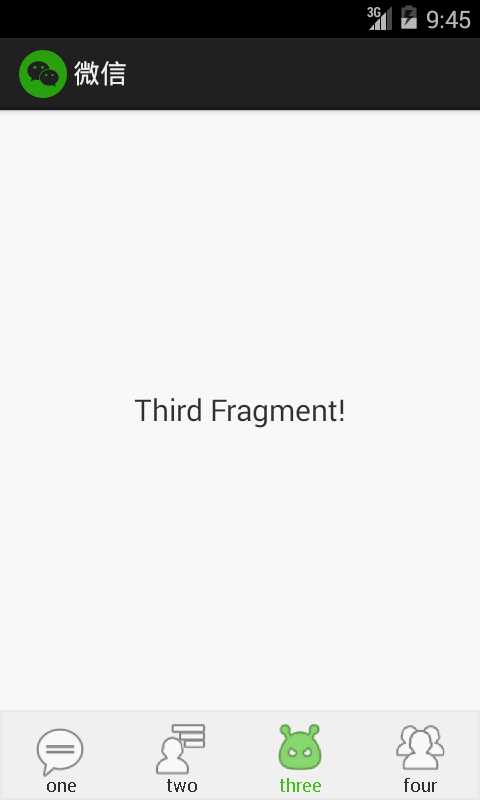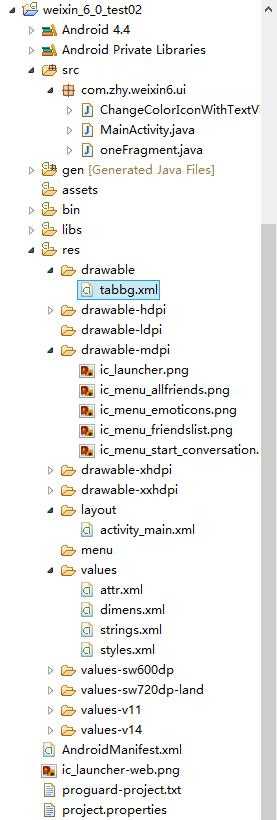标签:
http://www.cnblogs.com/AndroidJotting/p/4508805.html
相信大家对于微信5.0的切换效果一定很有印象,对于一些童鞋一定认为这是通过TabHost实现的,不过这里我要纠正一下你们的错误观点了,这个效果的实现是通过Fragment+ViewPage实现的,看上去简单的滑动切换,里面包含了很多腾讯工程师对于Android UI设计的独特视角和超强的业务能力,真心为他们点一个赞。说了这么多,下面我们开始探讨如何实现这样炫酷的效果,开始之前建议大家先看一下关于Fragment的介绍,这样会更好的帮助我们理解今天要介绍的知识。
我们本篇最后的设计效果:

下面我们开始今天的代码解析,让我们一起学习吧。
我们项目的目录结构:

第一步:创建自定义View实现底部切换按钮
对于微信主界面底部有4个类似按钮的小图标,这些小图标会随着我们滑动事件的改变而改变,开始绘制之前我们需要准备4张小图片,为我们接下来的开发做好准备。自定义View的代码:
public class ChangeColorIconWithTextView extends View
{
private Bitmap mBitmap;
private Canvas mCanvas;
private Paint mPaint;
/**
* 颜色
*/
private int mColor = 0xFF45C01A;
/**
* 透明度 0.0-1.0
*/
private float mAlpha = 0f;
/**
* 图标
*/
private Bitmap mIconBitmap;
/**
* 限制绘制icon的范围
*/
private Rect mIconRect;
/**
* icon底部文本
*/
private String mText = "微信";
private int mTextSize = (int) TypedValue.applyDimension(
TypedValue.COMPLEX_UNIT_SP, 10, getResources().getDisplayMetrics());
private Paint mTextPaint;
private Rect mTextBound = new Rect();
public ChangeColorIconWithTextView(Context context)
{
super(context);
}
/**
* 初始化自定义属性值
*
* @param context
* @param attrs
*/
public ChangeColorIconWithTextView(Context context, AttributeSet attrs)
{
super(context, attrs);
// 获取设置的图标
TypedArray a = context.obtainStyledAttributes(attrs,
R.styleable.ChangeColorIconView);
int n = a.getIndexCount();
for (int i = 0; i < n; i++)
{
int attr = a.getIndex(i);
switch (attr)
{
case R.styleable.ChangeColorIconView_icon:
BitmapDrawable drawable = (BitmapDrawable) a.getDrawable(attr);
mIconBitmap = drawable.getBitmap();
break;
case R.styleable.ChangeColorIconView_color:
mColor = a.getColor(attr, 0x45C01A);
break;
case R.styleable.ChangeColorIconView_text:
mText = a.getString(attr);
break;
case R.styleable.ChangeColorIconView_text_size:
mTextSize = (int) a.getDimension(attr, TypedValue
.applyDimension(TypedValue.COMPLEX_UNIT_SP, 10,
getResources().getDisplayMetrics()));
break;
}
}
a.recycle();
mTextPaint = new Paint();
mTextPaint.setTextSize(mTextSize);
mTextPaint.setColor(0xff555555);
// 得到text绘制范围
mTextPaint.getTextBounds(mText, 0, mText.length(), mTextBound);
}
@Override
protected void onMeasure(int widthMeasureSpec, int heightMeasureSpec)
{
super.onMeasure(widthMeasureSpec, heightMeasureSpec);
// 得到绘制icon的宽
int bitmapWidth = Math.min(getMeasuredWidth() - getPaddingLeft()
- getPaddingRight(), getMeasuredHeight() - getPaddingTop()
- getPaddingBottom() - mTextBound.height());
int left = getMeasuredWidth() / 2 - bitmapWidth / 2;
int top = (getMeasuredHeight() - mTextBound.height()) / 2 - bitmapWidth
/ 2;
// 设置icon的绘制范围
mIconRect = new Rect(left, top, left + bitmapWidth, top + bitmapWidth);
}
@Override
protected void onDraw(Canvas canvas)
{
int alpha = (int) Math.ceil((255 * mAlpha));
canvas.drawBitmap(mIconBitmap, null, mIconRect, null);
setupTargetBitmap(alpha);
drawSourceText(canvas, alpha);
drawTargetText(canvas, alpha);
canvas.drawBitmap(mBitmap, 0, 0, null);
}
private void setupTargetBitmap(int alpha)
{
mBitmap = Bitmap.createBitmap(getMeasuredWidth(), getMeasuredHeight(),
Config.ARGB_8888);
mCanvas = new Canvas(mBitmap);
mPaint = new Paint();
mPaint.setColor(mColor);
mPaint.setAntiAlias(true);
mPaint.setDither(true);
mPaint.setAlpha(alpha);
mCanvas.drawRect(mIconRect, mPaint);
mPaint.setXfermode(new PorterDuffXfermode(PorterDuff.Mode.DST_IN));
mPaint.setAlpha(255);
mCanvas.drawBitmap(mIconBitmap, null, mIconRect, mPaint);
}
private void drawSourceText(Canvas canvas, int alpha)
{
mTextPaint.setTextSize(mTextSize);
mTextPaint.setColor(0xff333333);
mTextPaint.setAlpha(255 - alpha);
canvas.drawText(mText, mIconRect.left + mIconRect.width() / 2
- mTextBound.width() / 2,
mIconRect.bottom + mTextBound.height(), mTextPaint);
}
private void drawTargetText(Canvas canvas, int alpha)
{
mTextPaint.setColor(mColor);
mTextPaint.setAlpha(alpha);
canvas.drawText(mText, mIconRect.left + mIconRect.width() / 2
- mTextBound.width() / 2,
mIconRect.bottom + mTextBound.height(), mTextPaint);
}
public void setIconAlpha(float alpha)
{
this.mAlpha = alpha;
invalidateView();
}
private void invalidateView()
{
if (Looper.getMainLooper() == Looper.myLooper())
{
invalidate();
} else
{
postInvalidate();
}
}
public void setIconColor(int color)
{
mColor = color;
}
public void setIcon(int resId)
{
this.mIconBitmap = BitmapFactory.decodeResource(getResources(), resId);
if (mIconRect != null)
invalidateView();
}
public void setIcon(Bitmap iconBitmap)
{
this.mIconBitmap = iconBitmap;
if (mIconRect != null)
invalidateView();
}
private static final String INSTANCE_STATE = "instance_state";
private static final String STATE_ALPHA = "state_alpha";
@Override
protected Parcelable onSaveInstanceState()
{
Bundle bundle = new Bundle();
bundle.putParcelable(INSTANCE_STATE, super.onSaveInstanceState());
bundle.putFloat(STATE_ALPHA, mAlpha);
return bundle;
}
@Override
protected void onRestoreInstanceState(Parcelable state)
{
if (state instanceof Bundle)
{
Bundle bundle = (Bundle) state;
mAlpha = bundle.getFloat(STATE_ALPHA);
super.onRestoreInstanceState(bundle.getParcelable(INSTANCE_STATE));
} else
{
super.onRestoreInstanceState(state);
}
}
}
第二步:设置自定义属性
在我们工程目录values下新建一个attr.xml,用来设置我们的自定义属性:
<?xml version="1.0" encoding="utf-8"?>
<!-- 自定义属性 -->
<resources>
<attr name="icon" format="reference" />
<attr name="color" format="color" />
<attr name="text" format="string" />
<attr name="text_size" format="dimension" />
<declare-styleable name="ChangeColorIconView">
<attr name="icon" />
<attr name="color" />
<attr name="text" />
<attr name="text_size" />
</declare-styleable>
</resources>
第三步:设置一个自定义属性
我们的Layout文件夹下新建一个drawable文件夹,在里面新建一个tabbg.xml:
<?xml version="1.0" encoding="utf-8"?>
<!-- 布局文件LinearLayout -->
<shape xmlns:android="http://schemas.android.com/apk/res/android" >
<stroke android:width="1dp" android:color="#eee" />
<solid android:color="#F7F7F7"/>
</shape>
第四步:设置主界面底部显示的文字
打开string.xml添加文字定义:
<?xml version="1.0" encoding="utf-8"?>
<resources>
<string name="app_name">微信</string>
<string name="tab_weixin">one</string>
<string name="tab_contact">two</string>
<string name="tab_find">three</string>
<string name="tab_me">four</string>
</resources>
第五步:布局文件
<LinearLayout xmlns:android="http://schemas.android.com/apk/res/android"
xmlns:zhy="http://schemas.android.com/apk/res/com.zhy.weixin6.ui"
xmlns:tools="http://schemas.android.com/tools"
android:layout_width="match_parent"
android:layout_height="match_parent"
android:orientation="vertical" >
<android.support.v4.view.ViewPager
android:id="@+id/id_viewpager"
android:layout_width="fill_parent"
android:layout_height="0dp"
android:layout_weight="1" >
</android.support.v4.view.ViewPager>
<LinearLayout
android:layout_width="fill_parent"
android:layout_height="60dp"
android:background="@drawable/tabbg"
android:orientation="horizontal" >
<com.zhy.weixin6.ui.ChangeColorIconWithTextView
android:id="@+id/id_indicator_one"
android:layout_width="0dp"
android:layout_height="fill_parent"
android:layout_weight="1"
android:padding="5dp"
zhy:icon="@drawable/ic_menu_start_conversation"
zhy:text="@string/tab_weixin"
zhy:text_size="12sp" />
<com.zhy.weixin6.ui.ChangeColorIconWithTextView
android:id="@+id/id_indicator_two"
android:layout_width="0dp"
android:layout_height="fill_parent"
android:layout_weight="1"
android:padding="5dp"
zhy:icon="@drawable/ic_menu_friendslist"
zhy:text="@string/tab_contact"
zhy:text_size="12sp" />
<com.zhy.weixin6.ui.ChangeColorIconWithTextView
android:id="@+id/id_indicator_three"
android:layout_width="0dp"
android:layout_height="fill_parent"
android:layout_weight="1"
android:padding="5dp"
zhy:icon="@drawable/ic_menu_emoticons"
zhy:text="@string/tab_find"
zhy:text_size="12sp" />
<com.zhy.weixin6.ui.ChangeColorIconWithTextView
android:id="@+id/id_indicator_four"
android:layout_width="0dp"
android:layout_height="fill_parent"
android:layout_weight="1"
android:padding="5dp"
zhy:icon="@drawable/ic_menu_allfriends"
zhy:text="@string/tab_me"
zhy:text_size="12sp" />
</LinearLayout>
</LinearLayout>
注意红色标注处xmlns:zhy="http://schemas.android.com/apk/res/com.zhy.weixin6.ui";com.zhy.weixin6.ui为工程包名。自定义属性的使用通过zhy引用。
第六步:我们的Fragment创建
public class oneFragment extends Fragment
{
private String mTitle = "one";
public oneFragment()
{
}
@Override
public View onCreateView(LayoutInflater inflater, ViewGroup container,
Bundle savedInstanceState)
{
if (getArguments() != null)
{
mTitle = getArguments().getString("title");
}
TextView textView = new TextView(getActivity());
textView.setTextSize(20);
textView.setBackgroundColor(Color.parseColor("#ffffffff"));
textView.setGravity(Gravity.CENTER);
textView.setText(mTitle);
return textView;
}
}
第七步:主Activity
@SuppressLint("NewApi")
public class MainActivity extends FragmentActivity implements
OnPageChangeListener, OnClickListener
{
private ViewPager mViewPager;
private List<Fragment> mTabs = new ArrayList<Fragment>();
private FragmentPagerAdapter mAdapter;
private String[] mTitles = new String[] { "First Fragment!",
"Second Fragment!", "Third Fragment!", "Fourth Fragment!" };
private List<ChangeColorIconWithTextView> mTabIndicator = new ArrayList<ChangeColorIconWithTextView>();
@Override
protected void onCreate(Bundle savedInstanceState)
{
super.onCreate(savedInstanceState);
setContentView(R.layout.activity_main);
mViewPager = (ViewPager) findViewById(R.id.id_viewpager);
initDatas();
mViewPager.setAdapter(mAdapter);
mViewPager.setOnPageChangeListener(this);
}
private void initDatas()
{
for (String title : mTitles)
{
oneFragment tabFragment = new oneFragment();
Bundle args = new Bundle();
args.putString("title", title);
tabFragment.setArguments(args);
mTabs.add(tabFragment);
}
mAdapter = new FragmentPagerAdapter(getSupportFragmentManager())
{
@Override
public int getCount()
{
return mTabs.size();
}
@Override
public Fragment getItem(int arg0)
{
return mTabs.get(arg0);
}
};
initTabIndicator();
}
//初始化按钮,设置点击监听
private void initTabIndicator()
{
ChangeColorIconWithTextView one = (ChangeColorIconWithTextView) findViewById(R.id.id_indicator_one);
ChangeColorIconWithTextView two = (ChangeColorIconWithTextView) findViewById(R.id.id_indicator_two);
ChangeColorIconWithTextView three = (ChangeColorIconWithTextView) findViewById(R.id.id_indicator_three);
ChangeColorIconWithTextView four = (ChangeColorIconWithTextView) findViewById(R.id.id_indicator_four);
mTabIndicator.add(one);
mTabIndicator.add(two);
mTabIndicator.add(three);
mTabIndicator.add(four);
one.setOnClickListener(this);
two.setOnClickListener(this);
three.setOnClickListener(this);
four.setOnClickListener(this);
one.setIconAlpha(1.0f);
}
@Override
//监听滑动事件
public void onPageSelected(int arg0)
{
}
@Override
//监听滑动事件
public void onPageScrolled(int position, float positionOffset,
int positionOffsetPixels)
{
if (positionOffset > 0)
{
ChangeColorIconWithTextView left = mTabIndicator.get(position);
ChangeColorIconWithTextView right = mTabIndicator.get(position + 1);
left.setIconAlpha(1 - positionOffset);
right.setIconAlpha(positionOffset);
}
}
@Override
//监听滑动事件
public void onPageScrollStateChanged(int state)
{
}
@Override
//监听点击事件
public void onClick(View v)
{
resetOtherTabs();
switch (v.getId())
{
case R.id.id_indicator_one:
mTabIndicator.get(0).setIconAlpha(1.0f);
mViewPager.setCurrentItem(0, false);
break;
case R.id.id_indicator_two:
mTabIndicator.get(1).setIconAlpha(1.0f);
mViewPager.setCurrentItem(1, false);
break;
case R.id.id_indicator_three:
mTabIndicator.get(2).setIconAlpha(1.0f);
mViewPager.setCurrentItem(2, false);
break;
case R.id.id_indicator_four:
mTabIndicator.get(3).setIconAlpha(1.0f);
mViewPager.setCurrentItem(3, false);
break;
}
}
/**
* 重置其他的Tab
*/
private void resetOtherTabs()
{
for (int i = 0; i < mTabIndicator.size(); i++)
{
mTabIndicator.get(i).setIconAlpha(0);
}
}
}
到这里我们的微信5.0主界面设计效果就实现完毕,大家可以测试一下,有什么疑问,欢迎留言讨论。下一篇:Fragment使用
标签:
原文地址:http://www.cnblogs.com/taoboy/p/4508843.html